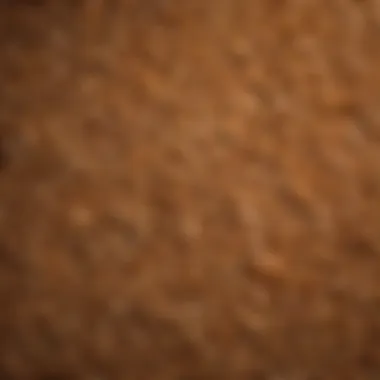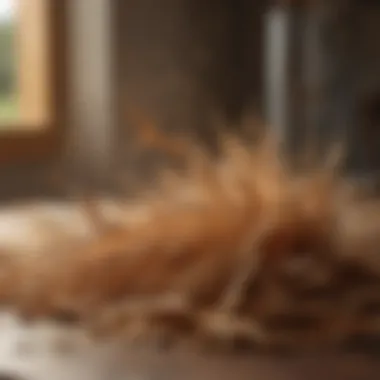Exploring Fine Pine Shavings: Uses and Benefits


Intro
Fine pine shavings have carved out a significant niche in various areas, from agriculture to woodworking. Often overlooked, these small particles of wood not only serve practical functions but also embody a sustainable solution to many industry needs. When exploring the world of home improvement, fine pine shavings shine due to their versatility, affordability, and numerous advantages.
The essence of fine pine shavings lies in their ability to address multiple challenges faced by homeowners and professionals alike, such as soil health, animal bedding, and as a substrate in various crafting endeavors. It's essential to recognize how these shavings can transform spaces, making them more functional, eco-friendly, and aesthetically pleasing.
Importance of Fine Pine Shavings
The significance of fine pine shavings is undeniable. The use of these shavings is not only an eco-conscious choice but also contributes to better soil structure and moisture retention. When it comes to gardening or landscaping, they can improve the quality of the soil, making it more conducive for plant growth. In the realm of animal husbandry, fine pine shavings provide a clean, absorbent, and comfortable bedding option that is gentle on livestock.
For the home improvement enthusiast, they present an economical alternative for various projects, often proving to be more cost-effective compared to other materials such as synthetic options. This affects not just budgets but also the environmental footprint of such projects, making fine pine shavings a preferred choice among many.
Foreword to Fine Pine Shavings
Fine pine shavings have carved a niche in various fields, serving multifunctional roles across agriculture, horticulture, and woodworking. Their unique structure and properties set them apart, making them a desirable option for both professional and casual users.
Fine pine shavings are not mere byproducts of the lumber industry; they offer numerous benefits that have caught the attention of savvy house owners and gardeners alike. Their versatility extends into improving soil health, providing comfort for livestock, and enhancing the final touches on crafted wood products. As we dive deeper into the specifics of fine pine shavings, it becomes clear just how far-reaching their applications are.
Definition and Composition
Fine pine shavings are thin, lightweight fragments derived from pine trees during the milling process. Typically, they are produced by planing the wood or through various woodworking processes which cut the lumber into smaller, manageable pieces. The composition primarily consists of cellulose and lignin, substances that not only contribute to its texture but also affect its durability and absorption capabilities. Often, the specific type of pine—like Eastern White Pine or Ponderosa Pine—determines the color, aroma, and even the moisture content of the shavings.
This fine texture promotes excellent aeration when used as a soil amendment, while also serving as a natural insulator in animal bedding. The ability to absorb moisture makes them a practical choice in various settings, showcasing both their functional and ecological value. Here’s a breakdown of their composition:
- Cellulose: Provides structure and makes up the bulk of the shavings.
- Lignin: Adds rigidity, aiding in durability.
- Aromatic oils: Impart a natural scent that can deter pests.
Historical Context
The use of fine pine shavings dates back centuries. Woodworking techniques have evolved, yet the practice of recycling lumber waste for practical applications has remained steadfast. In rural communities, pine shavings became crucial for animal bedding, owing to their absorbent nature. They not only offered comfort but also helped manage waste, making them a staple on farms.
As agriculture moved into modern times, fine pine shavings’ popularity spread beyond farms to gardens and homes. Gardeners began to appreciate their value as mulch and soil amendments. The historical journey from sawmill waste to essential gardening and farming resource demonstrates the ingenuity of finding utility in materials that were once considered mere scraps.
Understanding this rich context enhances the appreciation for fine pine shavings and their evolving role through time, reinforcing the notion that nature often provides solutions if one is willing to observe and adapt.
Sources of Fine Pine Shavings
Understanding where fine pine shavings come from is crucial for their effective utilization. This part of the article spotlights specific avenues through which these valuable materials can be obtained. The source affects not only the quality but also the ecological and economic implications associated with fine pine shavings. Given the diverse applications in agriculture, horticulture, and woodworking, the sourcing methods often dictate the end-user experience.
Sourcing from Lumber Mills
When it comes to sourcing fine pine shavings, lumber mills are often the first stop. These mills are equipped to process trees into various wood products, which inevitably generates a significant amount of shavings as a byproduct. The uniformity and quality of shavings that emerge from a milling process can be quite high due to the machinery utilized. Many mills offer fine pine shavings as a byproduct for sale, ensuring that they aren’t just discarded but repurposed effectively.
The benefits of using shavings sourced from lumber mills are manifold:
- Consistency: The shavings are produced in large batches and usually have a consistent size and texture.
- Quality Assurance: Since these mills handle the logs, they can assure buyers regarding the quality and source of the wood used.
- Cost Efficient: Sourcing from a mill can often be more economical than other methods.
However, one must consider factors like the specific milling practices and the treatment of the wood before deciding on the shavings. For instance, it’s important to confirm that no chemicals have been applied to the wood that could potentially harm livestock or soil health when using the shavings for mulching.
DIY Methods of Production
If purchasing fine pine shavings from a lumber mill isn’t an option, it’s entirely feasible to produce them oneself. This DIY approach appeals to many, especially those keen on sustainable practices and a hands-on approach to their needs. Creating your own pine shavings can be as simple as using a wood chipper or planer on pine wood.
To produce high-quality shavings, keep the following points in mind:
- Select the Right Wood: Pine is an excellent choice due to its natural properties. Avoid treated wood to ensure safety.
- Equipment: A wood planer or a chipper can do the trick. A planer provides more consistent shavings, while a chipper creates varied sizes.
- Safety Precautions: Always wear goggles and a mask to protect against dust and debris.
- Storage: Once produced, store the shavings in a dry, ventilated space to avoid clumping or mold.
Producing your own fine pine shavings can save money and ensure that you are fully aware of what your shavings contain.
"Knowing the source of your pine shavings can make all the difference in ensuring their effectiveness and safety."
By understanding the aspects of sourcing from lumber mills and embracing DIY methods, homeowners can make informed decisions regarding their choices in fine pine shavings.
Agricultural Applications
Fine pine shavings play a pivotal role in agriculture, serving various essential functions that enhance overall productivity and animal well-being. Their unique properties make them suitable for multiple uses, particularly for livestock care and crop management. Understanding how these shavings can be utilized effectively contributes to more sustainable and efficient agricultural practices.
Use as Animal Bedding
Benefits for Livestock Comfort
When it comes to livestock, comfort is non-negotiable. Fine pine shavings provide a soft and cushioned bedding option that greatly benefits animals such as cows, horses, and pigs. The key characteristic of these shavings is their ability to conform to the animal's body, reducing pressure points and promoting restful sleep. This leads to healthier livestock with better growth rates, ultimately translating into improved productivity for farmers.


One unique feature of using fine pine as bedding is its excellent absorption qualities. The shavings can soak up moisture and odors effectively, making the environment more pleasant for both the animals and their caretakers. However, it’s also essential to monitor the shavings regularly, as damp conditions can lead to mold or bacteria, posing potential health risks.
Odor Control Properties
An appealing aspect of fine pine shavings is their remarkable ability to control odors. They naturally release aromatic compounds that not only mask unpleasant smells but also deter pests. This beneficial property makes them a popular choice among farmers, as an odor-free environment enhances the overall livability for livestock.
The unique feature of fine pine shavings related to odor control lies in the compounds present in the wood. These shavings don't just cover up odors; they actively break down organic matter that causes them. However, it’s worth noting that, over time, the effectiveness of odor control might diminish, necessitating timely replacement of the bedding.
Mulching in Crop Production
Fine pine shavings are not limited to livestock use; they also find crucial applications in crop production, especially in mulching practices.
Soil Moisture Retention
Soil moisture retention is another significant benefit derived from using fine pine shavings as mulch. These shavings act as a barrier, reducing evaporation rates and helping maintain consistent moisture levels in the soil. The key characteristic of this practice is that it effectively conserves water, which is especially crucial during dry spells.
The unique feature of fine pine shavings lies in their ability to create a microclimate. By regulating soil temperature and moisture, they enhance microbial activity which is vital for healthy plant growth. Farmers using these shavings often report healthier crops and reduced irrigation needs. On the flip side, over-application could result in nutrient depletion as organic matter breaks down, hence careful monitoring is advisable.
Weed Suppression Techniques
Weed control is an ever-present challenge in agriculture, and fine pine shavings can step in as a natural solution. By acting as a physical barrier, they effectively inhibit weed seed germination, allowing desired crops to flourish. The key characteristic of this method is its simplicity and effectiveness, particularly in organic farming where chemical herbicides are often avoided.
Using fine pine shavings for weed suppression also has unique advantages. They break down slowly, offering long-term weed control which minimizes labor and resource inputs over time. However, as with all agricultural practices, balance is necessary. Too much mulch can hinder the growth of certain crops and might cause competition for resources.
"Fine pine shavings are not just a bedding material; they are an essential part of a holistic approach to sustainable agriculture, improving both livestock health and crop yields."
In summary, fine pine shavings provide compelling benefits in agricultural applications, from enhancing animal comfort to fostering healthier crops. Their unique properties make them a versatile tool for farmers looking to improve productivity and sustainability.
Horticultural Benefits
When it comes to the realm of horticulture, fine pine shavings have garnered attention for their multifaceted benefits that can enhance not just plant growth, but the overall health of the garden ecosystem. With the right application, these shavings can play an invaluable role in creating sustainable and productive planting environments. Here’s an insight into how fine pine shavings can positively influence horticultural practices.
Enhancement of Soil Structure
Fine pine shavings contribute significantly to the structure of soil, promoting better aeration and drainage. When cultivated soil is mixed with these shavings, it prevents compaction, allowing roots to penetrate more easily and absorb water and nutrients effectively. Additionally, their fibrous nature aids in holding moisture during dry spells.
Broadly speaking, here are some advantages of using fine pine shavings for soil enhancement:
- Improved Aeration: The air pockets created by the shavings allow for better oxygen flow to plant roots, fostering healthy growth.
- Moisture Retention: Their ability to hold water can be a boon during those blistering hot summer months.
- Disease Resistance: By maintaining a healthier soil structure, plants show increased resistance to diseases.
Fertilization Aspects
Fertilization is another critical area where fine pine shavings shine through. They don't merely serve as a physical amendment; they can be valuable in improving the nutrient profile of the soil as they break down over time.
Nutrient Gradation
The nutrient gradation provided by fine pine shavings is a significant aspect of their contribution to horticulture. Over the months following their application, these shavings undergo decomposition. As this process unfolds, they release nutrients gradually, making them available to plants systematically rather than all at once. This slow-release mechanism is especially important for high-demand plants.
Key features of nutrient gradation include:
- Sustained Release: Nutrients become accessible at varying intervals, reducing the chance of nutrient leaching during heavy rains.
- Balanced Nutrition: Fine pine shavings can enhance nutrient balance, key for developing strong, healthy plants.
- Low Risk of Burn: Unlike certain fertilizers, the gradual release means there’s little risk of harming plants with excess.
With pine shavings, this characteristic makes them a popular choice among gardeners who are concerned about maintaining a stable nutrient supply.
Microbial Activity
Microbial activity is essential for nutrient cycling within the soil ecosystem. Fine pine shavings provide an excellent habitat for beneficial microbes as they break down. As these microbes digest the organic material, they release essential nutrients and compounds that plants need for optimal growth. Increased microbial diversity can lead to healthier soil, promoting a balanced ecosystem.
Notable aspects of microbial activity related to fine pine shavings include:
- Enhancing Soil Biology: Fostering a robust microbial community helps to improve the overall health of soil.
- Boosting Nutrient Accessibility: The metabolic activities of microbes lead to greater nutrient availability for plants, better supporting their growth needs.
- Soil Amendment: As microbial activity increases, soil structure improves, enhancing its fertility over time.
This active role of fine pine shavings in promoting microbial growth aligns perfectly with sustainable gardening practices.
In summary, fine pine shavings are not just organic waste; they can be powerful allies in horticulture, enhancing soil structure and nutrition while encouraging beneficial life in the garden. The multifaceted benefits they provide drastically increase their value to both amateur and seasoned gardeners alike.
Woodworking Utilization
Woodworking is a craft that combines skill and creativity, allowing artisans to create functional and artistic pieces. The role of fine pine shavings in this arena is both practical and aesthetic. Using fine pine shavings not only enhances the final product but also reflects a commitment to sustainability. These shavings are often derived from sustainably managed forestry, making them an eco-friendly choice for woodworkers who value their environmental footprint.
Sawdust and Shavings in Projects
When you're at the lumber yard, you might see sawdust and shavings piled high, often overlooked. Yet these remnants of the woodworking process can be gems in disguise. For everything from crafting furniture to intricate décor, fine pine shavings offer numerous benefits.


- Versatility: They can be incorporated into a variety of projects, from rustic furniture designs to intricate carvings.
- Weight: Fine pine shavings are lightweight, making them easy to manipulate and add to projects, without compromising the structure or stability of the final piece.
- Cost-effectiveness: Instead of purchasing premium wood for certain aspects, integrating shavings can save costs while maintaining aesthetic appeal.
In particular, many woodworkers find that integrating fine pine shavings into composite material formulations can yield enhanced textures and finishes. This aspect allows for innovation in forms and designs that stand out.
Finishing Touches for Crafts
Woodworking is not just about the structural integrity of a piece; it’s also about how it feels and looks. Fine pine shavings play a significant role in the finishing process, adding finesse and character to the final product.
Surface Texture Improvement
Surface texture is one of the first things people notice, and using fine pine shavings can be a game changer.
- Key Characteristic: The unique fibrous nature of fine pine shavings creates a pleasant tactile experience while also providing an attractive visual.
- Why Popular: Craftsmen love incorporating these shavings as they are easy to work with and blend smoothly with various finishes, enhancing the overall appearance.
- Unique Feature: They have a uniform texture, which helps in achieving a polished look without the rough edges often associated with raw wood.
This texture improvement offers a substantial advantage in woodworking, giving pieces a professional aesthetic without requiring extensive additional processing.
Environmentally Friendly Alternatives
In today’s world, choosing environmentally friendly materials has become vital for many woodworkers.
- Key Characteristic: Fine pine shavings are a byproduct of the lumber industry, which means they come from a sustainable source. This aspect lessens the need for additional logging and minimizes waste.
- Why Beneficial: Using these shavings contributes to a circular economy where waste materials find new life in the crafting process.
- Unique Feature: They can also be used to create composite materials, combining them with adhesives to produce strong, eco-friendly panels.
The advantages of fine pine shavings truly shine here; they not only reduce the impact of woodworking on the environment but also offer a practical, resourceful solution for creatives aiming for a lower carbon footprint.
"Incorporating pine shavings isn’t just a smart choice for aesthetics; it aligns with the sustainability goals many of us hold dear. It feels good to used what’s often considered waste."
By integrating fine pine shavings into various aspects of woodworking, crafters can achieve not only beautiful and tactile pieces but also promote an ethos of sustainability and resourcefulness. Whether you are a seasoned woodworker or a novice enthusiast, embracing fine pine shavings can elevate your projects to new heights.
Environmental Considerations
When discussing fine pine shavings, it would be remiss to overlook the pivotal role that environmental considerations play in both their sourcing and application. Using fine pine shavings can align with broader ecological objectives, helping to promote sustainability while minimizing adverse effects on the planet. As we delve into this subject, we find that several nuanced factors come into play, including the sustainability of pine sources and their carbon footprint, both of which are integral to understanding the full spectrum of benefits associated with these materials.
Sustainability of Pine Sources
Sustainability has become a buzzword in our modern age, and rightly so, as we find ourselves grappling with environmental degradation. Pine forests are often managed carefully to ensure that the harvesting of trees does not deplete resources or disrupt the local ecosystem. When discussing the sustainability of pine sources, it’s worth noting that most commercial pine operations prioritize regeneration. This means for every tree felled, several saplings are planted to take their place.
Moreover, fine pine shavings are primarily produced as a byproduct of lumber milling. In this context, they hold less environmental impact when compared to other materials that require more intensive harvesting and processing. Utilizing what is essentially waste material not only lessens the load on landfills but also transforms these shavings into a valuable resource.
Additionally, sustainable pine forestry adheres to strict management practices that often include:
- Selective logging: Only certain trees are harvested based on age and health.
- Minimal chemical use: Many forestry operations reduce or eliminate the use of pesticides and fertilizers.
- Biodiversity promotion: Ensuring a variety of species are supported helps maintain the health of the ecosystem.
By opting for fine pine shavings sourced from responsible producers, users can contribute to more sustainable practices and enjoy the peace of mind that goes along with it. The forest, once perceived merely as a source of lumber, proves to be a complex, living ecosystem that benefits from thoughtful cultivation.
Carbon Footprint Analysis
The carbon footprint of a product encompasses the total greenhouse gas emissions associated with its life cycle—from production to disposal. When it comes to fine pine shavings, the carbon journey is somewhat optimistic. First off, pine trees are carbon absorbers; during their growth, they capture carbon dioxide from the atmosphere, helping to mitigate climate change. This inherent characteristic means that sourcing pine for shavings from sustainably managed forests contributes positively to the carbon cycle.
Upon harvesting, the processing of pine into fine shavings generally requires less energy than the production of many synthetic alternatives. Additionally, because these shavings are often derived from leftover materials of lumber production, they do not necessitate additional deforestation. Thus, they provide a double whammy by not only recycling waste but also reducing the need for new resource extraction.
It is also important to consider that when used as mulch or bedding, fine pine shavings decompose over time, enriching the soil and further contributing to the ecosystem. This means that not only is their use beneficial in the immediate term, but it also has long-term positive effects as they break down and support soil health.
As the world continues to lean toward environmentally sound practices, adopting products like fine pine shavings can be part of the solution.
"Utilizing materials like fine pine shavings reflects a dual commitment to efficiency and environmental stewardship."
Economic Impact
The economic impact of fine pine shavings extends beyond mere cost considerations. They serve as an essential resource across various industries, particularly in agriculture, horticulture, and woodworking. People often overlook the financial benefits these shavings can provide, but they play a significant role in optimizing production costs, which can ultimately influence profit margins. As a versatile material, fine pine shavings deliver value, making them a priority for more sustainable practices.
Cost Analysis of Fine Pine Shavings
When evaluating the cost of fine pine shavings, several factors come into play which can affect end-users.
- Purchase Price: The price of fine pine shavings primarily depends on the source. For instance, buying directly from lumber mills often yields more competitive rates compared to retail outlets. Often, when customers buy in bulk, discounts are available, which can provide significant savings over time.
- Handling and Application Costs: Beyond the initial purchase, costs associated with storage and application should not be disregarded. Proper storage techniques can minimize waste and maintain quality over time, thus impacting long-term expenditures.
- Comparative Cost Efficiency: When weighing the use of fine pine shavings against alternative bedding materials or mulching options, they often prove to be a more cost-effective solution. They generally require less frequent replacement compared to straw and other organic materials.
The best way to summarize costs is that fine pine shavings, while initially appearing as an expense, can offer an overall economical advantage when properly integrated and utilized across multiple practices. Whether for animal bedding or as mulching material, efficiency in both cost and application leads to lower operational costs in the long run.
Market Trends and Demand
The demand for fine pine shavings has seen an upward trend in several sectors lately. Increasing awareness of their benefits has caught the eye of various producers and consumers alike.


- Growing Agricultural Practices: With many farmers looking for sustainable and eco-friendly alternatives, fine pine shavings are becoming a preferred choice. Their lightweight nature, combined with excellent absorption characteristics, makes them ideal for animal bedding. This trend aligns with a broader movement towards sustainable farming, adding to their appeal.
- Horticultural Boom: The expanding interest in gardening and landscaping also stimulates market demand. As more households engage in gardening, the versatility of pine shavings as mulch becomes appealing. They not only improve aesthetics but also help manage soil temperature and moisture.
- Woodworking Return: Moreover, hobbies related to woodworking and crafting have seen significant growth. Enthusiasts are increasingly searching for materials that support high-quality finishes; fine pine shavings fulfill this need and are being purchased frequently for craft projects.
In essence, market demand for fine pine shavings is trending positively, driven by their multipurpose nature and sustainability benefits. They are solidifying their standing as a crucial commodity in various sectors.
Challenges and Limitations
When diving into the world of fine pine shavings, it’s critical to address not just the bright side but also the challenges and limitations that come with them. Many enthusiasts and users may find themselves enamored by the myriad of applications fine pine shavings offer— from nurturing the soil to providing comfort for livestock. However, like a two-sided coin, understanding the potential pitfalls is equally important. This section illuminates key challenges, primarily focused on potential contaminants and logistical issues in distribution, ensuring you are well-informed about your choices.
Potential Contaminants
As with any natural product, fine pine shavings aren’t immune to contaminants. Either during the harvesting process or in the stages before they reach you, impurities can sneak in. One concern lies in the use of treated wood, which may contain chemicals harmful to plants and animals. For example, if shavings come from lumber that has been treated with preservatives, these can leach into the soil and pose risks to crops or animal health.
Another factor to consider is the possibility of mold and mildew, particularly if the shavings are stored improperly. In humid conditions, these fungi can flourish, leading to health issues for animals or compromising the quality of the mulch.
Here’s a checklist to keep in mind while selecting fine pine shavings:
- Source verification: Always ask where the shavings originate from. Ensure that they come from untreated pine timber.
- Visual inspection: Check for any signs of mold or unusual odors that might indicate spoilage.
- Storage conditions: Make sure that the storage area is dry and well-ventilated.
"In your quest for fine pine shavings, due diligence will save you from potential headaches down the line."
Logistical Issues in Distribution
Logistics play a significant role in the overall usability of fine pine shavings. While they may seem straightforward to obtain, there’s often a web of challenges lying beneath the surface regarding their transportation and delivery. One issue can arise from the bulkiness of shavings, making them heavier and more cumbersome than one might anticipate. This can lead to increased shipping costs, especially for smaller producers who may not have economies of scale like larger operations.
In addition, local availability varies greatly. In some areas, finding high-quality fine pine shavings may feel like searching for a needle in a haystack. Without a reliable supplier, individuals may need to travel considerable distances, which isn’t always feasible or economical. Furthermore, a spike in demand, perhaps due to an agricultural or gardening surge, can lead to shortages in supply.
Here are a few things you can do to navigate these challenges:
- Research local suppliers: Building a rapport with local lumber yards or agricultural suppliers can streamline access.
- Plan ahead: If you expect to need a large quantity, consider ordering in advance to avoid any supply crunches.
- Explore alternatives: If fine pine shavings become scarce, look into other organic mulching options that could serve similar purposes.
Being aware of challenges like potential contaminants and logistical issues can help you make informed decisions and ensure you can reap the maximum benefits from fine pine shavings, whether you're tending to your garden or ensuring livestock comfort.
Best Practices for Utilization
When it comes to fine pine shavings, understanding the best practices for utilization can significantly enhance their effectiveness and benefits across various applications. Proper usage not only ensures optimal results but also maximizes the economic and environmental advantages. In both agricultural and horticultural settings, implementing thoughtful approaches to storing and applying fine pine shavings leads to better outcomes.
Optimal Storage Techniques
Storing fine pine shavings correctly is vital to preserve their integrity and usefulness. Here are some key pointers regarding storage:
- Keep It Dry: Moisture can turn your fine pine shavings into a soggy mess, which might invite mold and pests. Ensure your storage area is well-ventilated and protected from rain.
- Use Sealed Containers: Ideally, store shavings in airtight containers or sealed bags. This prevents external contaminants from affecting the quality of the shavings while keeping them dry.
- Cool, Dark Spaces: Just like a fine wine, fine pine shavings benefit from being kept out of direct sunlight. A cool and dark place minimizes the risk of degradation.
Taking these measures helps in maintaining the freshness and efficacy of the shavings, ensuring that when it’s time to use them, they deliver on their promises.
Application Guidelines
Knowing how to properly apply fine pine shavings can make a world of difference in their effectiveness. Here are some simple yet essential application guidelines:
- Layering for Bedding: When using shavings for animal bedding, apply a thick layer (about 4 to 6 inches). This deep bedding provides comfort, absorbs moisture, and controls odors efficiently.
- In Gardens as Mulch: Spread fine pine shavings evenly around the base of plants for mulching. A layer of approximately 2 to 4 inches can significantly aid in moisture retention while suppressing pesky weeds.
- Rotate and Replace: Regularly check the bedding or mulch for signs of degradation. For animal bedding, replace the shavings when they begin to appear soiled. In gardens, topping off with fresh shavings every few months helps maintain an effective mulch layer.
By following these clear guidelines, enthusiasts can leverage the multifaceted benefits of fine pine shavings, whether for gardening, animal care, or crafting.
"Utilizing fine pine shavings with proper techniques not only enhances soil health but also safeguards the well-being of livestock, making your efforts in caring for your homestead all the more worthwhile."
In summary, mastering the best practices for utilizing fine pine shavings is essential for both housewives and homeowners looking to improve their gardens and livestock care. Paying close attention to storage and application will yield the best results all around.
Ending
In reflecting upon the multifaceted applications and advantages of fine pine shavings, it becomes clear that these natural byproducts offer more than just simple utility—they enhance various sectors of our daily lives. From their role in agriculture as effective animal bedding to their use in enhancing soil health, fine pine shavings serve as a bridge between sustainable practices and practical applications. As homeowners or those deeply engaged in gardening, understanding these insights is crucial for making informed decisions that reflect your values and enhance your environment.
Summarizing Key Insights
The key insights from this exploration can be summarized as follows:
- Versatility in Use: Fine pine shavings can be utilized across various sectors including agriculture, horticulture, and woodworking, showcasing their adaptability in different environments.
- Environmental Benefits: Their ability to enhance soil structure and support pest resistance contributes positively to sustainable growing practices, reducing the need for chemical interventions.
- Economic Value: The use of fine pine shavings can also lead to financial savings, whether through reducing costs related to animal care or assisting in clean and healthy plant growth.
- Best Practices: Storing them properly and applying them correctly ensures they achieve their maximum potential, benefiting both plants and animals.
These elements not only highlight the importance of fine pine shavings but also reiterate how even simple materials can lead to significant positive impacts on both personal and environmental health.
Future Prospects for Fine Pine Shavings
Looking ahead, the future prospects for fine pine shavings appear promising. With ongoing research into their properties and extensions into various applications, we will likely see an increase in their utilization. Several factors play a role in this. For one, as sustainable practices gain traction, more homeowners and farmers are likely to turn to biodegradable and environmentally friendly options like pine shavings.
Moreover, innovations in processing and application may enhance their effectiveness. For instance:
- Research into Blending: There might be potential for blending fine pine shavings with other organic materials to improve their attributes further.
- Increased Automation: Developments in technology could lead to automated methods for applying pine shavings in agricultural fields, improving efficiency.
- Heightened Awareness: Awareness campaigns could serve to educate more individuals on the benefits of utilizing such natural materials, expanding their market reach.
"As society moves towards more sustainable practices, the role of materials like fine pine shavings in our lives will only continue to grow."
While many may overlook them, fine pine shavings are on the path to becoming a crucial component in both sustainable living and enhancement of our gardening and household projects. Embracing this future will not only benefit the immediate environment but also contribute positively to ecological efforts on a larger scale.







